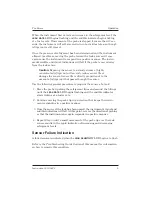
8
Tru Pointe
Instruction 0019-9328
Low Battery Indication
A low-battery condition is indicated when the green
POWER
ON
LED begins
to
fl
ash. Approximately 20 minutes of operation time remains from the
time this LED
fi
rst begins to
fl
ash; after which, the instrument’s operation
will gradually become erratic.
When a low-battery indication occurs, replace the batteries as described
under the previous Section
Battery Installation.
Selecting High / Low Sensitivity Mode
When the Tru Pointe is
fi
rst turned ON it defaults to its low-sensitivity
mode.
Place the instrument into its high-sensitivity mode by pressing the
HIGH
/
LOW
SENSITIVITY
button until the
HIGH
SENSITIVITY
LED turns ON (
HIGH
SENSITIVITY
amber LED glows).
Tip:
Use the low-sensitivity mode to extend battery and sensor
life. Use the high-sensitivity mode, if necessary, to pinpoint leaks.
Return the instrument to its low-sensitivity mode by pressing the
HIGH
/
LOW
SENSITIVITY
button until the
HIGH
SENSITIVITY
LED turns OFF.
Procedure for Locating a Refrigerant Leak
After the instrument is turned ON and allowed to warm up, observe that
both the
LEAK
RATE
LED and the audible indicator should be
fl
ashing/tick-
ing at no more than 1 or 2 times a second, indicating that the instrument
is in its idle state and currently
not
detecting an
increasing
concentration
of refrigerant.
Important:
The instrument’s function is to detect a
change
in refrigerant level, and not to make a quantitative mea sure -
ments. The technique of locating a leak by detecting a change
in level allows an op er a tor to quickly locate the source of a
leak without making manual sensitivity ad just ments, or be-
ing concerned about the background refrigerant level in the
sur round ing area.
Begin by slowly moving the probe tip toward the area of the suspected leak
source. If surfaces are dirty or wet, wipe them off with a shop towel. Avoid
allowing dirt to clog the probe tip, or allowing water to enter the instrument.
Operation




















